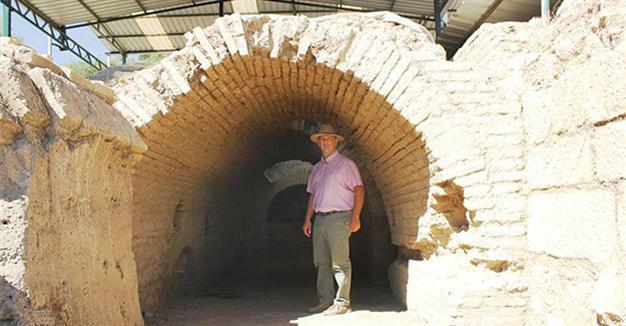Well-preserved bath structure found
İZMİR - Doğan News Agency

DHA photo
Archaeological excavations in the ancient city of Metropolis, located between the Yeniköy and Özbet neighborhoods in the Aegean city of İzmir’s Torbalı district, have unearthed one of the best-preserved brick vault structures in the world. The structure, a part of a bath-palaestra complex, dates back to 1,900 years ago.It is believed that the ancient structure was used to transfer hot water to the pools in the caldarium (hot plunge bath) section of the bath complex. The fact that its construction technique is similar to the Vedius Gymnasium in Ephesus has lead officials to hypothesize that both structures were constructed by the same team.
Manisa Celal Bayar University Archaeology Department member Serdar Aybek heads the excavations in Metropolis, which gained ancient site status last year. The Roman bath–palaestra complex covers an area of 5,000 square meters.
“Works in the service corridor that started in 2013 are almost done. We have seen a similar and larger brick vault structure in the ancient city of Ephesus, too. Besides the construction technique and the short distance between the two towns, both structures were constructed in the period of Roman Emperor Antoninus Pius, which makes us think that the same masters worked on them. It is also possible to see a similarity in the geometrical designs on the mosaics. But we don’t have an epigraphic find to support this hypothesis yet. The survival of this place, which is one of the best-preserved brick vault service corridors in the world, is a blessing in the name of archaeology. Even the terrace part of the structure is completely solid. The 2,000-year-old footprints of an animal and a boy, which were discovered a few years ago on the plaster on the terrace, received great interest from the media, too,” said Aybek.
Speaking about the bath, Aybek said, “The bath was expanded in the 2nd century B.C. in the time of Antoninus Pius. During the expansion, new sections for eating and drinking, as well as bathing, were added. People used to spend their whole day in this place. These bath structures were social areas, places of attraction.”
With this year’s excavations, the connections between the service corridors have been completed. These service corridors were used by servants to heat the bath. These servants and people in the bath were not able to see each other.
The western parts of the U-shaped corridors are 30 meters in length and 5.5 meters in height. There is a ventilation pipe every five meters in the corridors for servants to work easily.
Other finds in the city
The bath’s caldarium, tepidarium (warm section), frigidarium (cold section), festive rooms, marble and mosaic rooms, palaestra and mosaic porticos were unearthed in previous years.
Other artifacts that have been found during excavations in the ancient city in the past include a Hellenistic era theater, an assembly building, a portico, two Roman era baths, a complex of baths and sports field, a peristillium house, stores, a toilet and streets. Also, tens of thousands of findings including Hellenistic and Roman era ceramics, coins, glasses, architectural pieces and sculptures have been discovered in the ancient city.
A cult area built for Zeus, the main god of the ancient Helen mythology, was also found last year.
















